Tredway, L.P. and L.L. Burpee. 2001. Rhizoctonia diseases of turfgrass. The Plant Health Instructor. DOI: 10.1094/PHI-I-2001-1109-01
Updated 2006.
Rhizoctonia diseases of turfgrass
Rhizoctonia species
Warm- and cool-season turfgrasses
Authors
Lane P. Tredway, University of Georgia, Athens
Lee L. Burpee, University of Georgia, Griffin
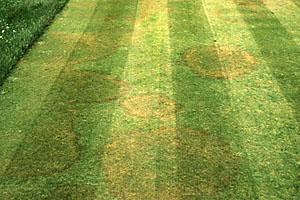
Brown patch of colonial bentgrass on a golf course tee
Symptoms and Signs
Brown Patch
Brown patch, caused by Rhizoctonia solani, is a disease of cool-season grasses, including bentgrasses, bluegrasses, fescues, and ryegrasses. Brown patch commonly occurs during periods of warm and humid weather. As the name implies, gross symptoms of brown patch are brown or tan patches of diseased turf ranging in diameter from 5 cm (2 in.) up to 1 m (3 ft) or more in diameter (Figure 1, Figure 2, Figure 3, Figure 4, Figure 5). When close-cut turf (<2.5 cm or 1 in.) is wet, brown patches are often surrounded by a dark brown or gray ring called a "smoke ring" (Figure 6, 7). The smoke ring is evidence of active fungal growth on the turf foliage and is an initial sign of brown patch development. Brown patch typically does not result in damage to all tillers within a developing patch (Figure 8), therefore, the turf may recover when disease pressure is reduced by change in weather conditions or implementation of control practices.
Symptoms and Signs
Brown Patch
Brown patch, caused by Rhizoctonia solani, is a disease of cool-season grasses, including bentgrasses, bluegrasses, fescues, and ryegrasses. Brown patch commonly occurs during periods of warm and humid weather. As the name implies, gross symptoms of brown patch are brown or tan patches of diseased turf ranging in diameter from 5 cm (2 in.) up to 1 m (3 ft) or more in diameter (Figure 1, Figure 2, Figure 3, Figure 4, Figure 5). When close-cut turf (<2.5 cm or 1 in.) is wet, brown patches are often surrounded by a dark brown or gray ring called a "smoke ring" (Figure 6, 7). The smoke ring is evidence of active fungal growth on the turf foliage and is an initial sign of brown patch development. Brown patch typically does not result in damage to all tillers within a developing patch (Figure 8), therefore, the turf may recover when disease pressure is reduced by change in weather conditions or implementation of control practices.
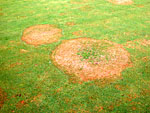
Figure 1 |
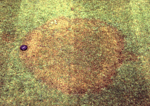
Figure 2 |
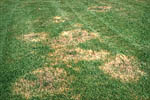
Figure 3 |
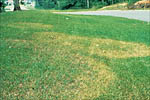
Figure 4 |
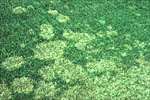
Figure 5 |
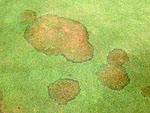
Figure 6 |
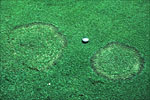
Figure 7 |
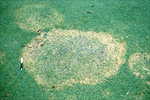
Figure 8 |
Symptoms observed on individual plants vary according to the height of mowing. On turf maintained above 2.5 cm (1 in.), irregular silver-gray or tan lesions with a thin, dark brown border are observed on the leaves (Figure 9). On close-cut turf (<2.5 cm or 1 in.), no distinct lesions are readily observed, but the symptoms appear as general leaf necrosis.
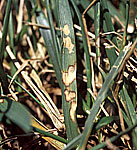
Figure 9 |
Large Patch
Rhizoctonia solani also causes large patch, a disease of warm-season grasses, including bermudagrass, centipedegrass, St. Augustinegrass, and zoysiagrass. Large patch occurs during the spring and fall, when warm-season turfgrasses are entering or exiting their period of winter dormancy. Circular patches of diseased turf are observed, ranging in diameter from less than 1 m (3.3 ft) up to 8 m (26.4 ft) (Figure 10, Figure 11, Figure 12, Figure 13). Leaves of recently infected turf, located at the periphery of the patch, may appear orange in color (Figure 14). Some patches may be perennial, recurring in the same location and expanding in diameter year after year. In contrast to brown patch, R. solani infection of warm-season grasses occurs on the leaf sheaths, where water-soaked, reddish-brown or black lesions are observed (Figure 15). Foliar dieback from the leaf tip toward the base occurs as a direct result of these leaf sheath infections.
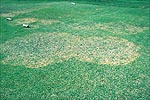
Figure 10 |
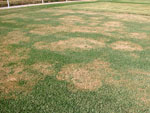
Figure 11 |
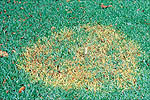
Figure 12 |
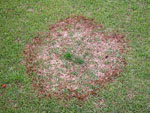
Figure 13 |
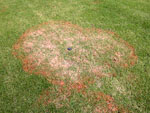
Figure 14 |
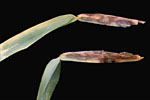
Figure 15 |
Leaf and Sheath Spot
Leaf and sheath spot is a collective term used for turfgrass diseases caused by two Rhizoctonia species: R. zeae and R. oryzae. Because these diseases are relatively uncommon in occurrence, their etiologies have not yet been thoroughly characterized. Rhizoctonia zeae has been isolated from lesions on tall fescue that appeared similar to brown patch lesions. On creeping bentgrass, R. zeae has been associated with patches of diseased turf ranging in color from dark gray or brown to orange (Figure 16). A “smoke ring” similar to that associated with brown patch may also appear (Figure 17). On centipedegrass and St. Augustinegrass, both R. zeae and R. oryzae cause leaf sheath lesions, similar to those induced by R. solani. In addition, R. zeae has been associated with a diffuse foliar blight of bermudagrass. Further research on the etiology of these diseases is required to facilitate accurate disease diagnosis and management.
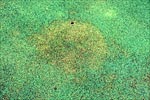
Figure 16 |
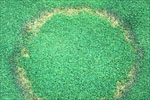
Figure 17 |
Yellow Patch
Yellow patch, caused by R. cerealis, is a disease of cool-season turfgrasses that occurs during periods of cool, wet conditions. This disease has also been observed infrequently on bermudagrass and zoysiagrass. In turfgrass swards, yellow to tan, irregularly shaped patches or rings are observed, ranging in diameter from 15 cm (6 in.) up to 1 m (3.3 ft) (Figure 18; Figure 19). Rhizoctonia cerealis incites a foliar blight, but no distinct foliar lesions, smoke rings, or any other signs of pathogen activity are readily observed. A disease similar to yellow patch has been observed in Japan, where the pathogen has been identified as Rhizoctonia AG-Q.
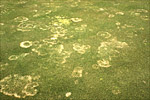
Figure 18 |
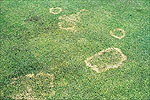
Figure 19 |
Pathogen Biology
Rhizoctonia
Rhizoctonia belongs to a group of fungi called the "Mycelia Sterilia." These fungi do not produce asexual spores, but grow by producing thin, vegetative strands called hyphae (Figure 20). In recent years, the sexual stages, or teleomorphs, of many Rhizoctonia species have been characterized and classified in the basidiomycete genera Thanatephorus, Waitea, and Ceratobasidium. However, these sexual stages are rarely seen in nature, so the classification in the Mycelia Sterilia has been maintained.
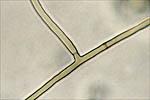
Figure 20 |
Because Rhizoctonia species often do not produce spores, these fungi are identified by characteristics of their hyphae. Rhizoctonia hyphae produce branches at right and acute angles to the main hypha, the branch hypha is slightly constricted at the branch origin, and there is often a septum near the branch origin (Figure 20). Rhizoctonia species also produce specialized hyphae composed of compact cells called monilioid cells (Figure 21). The monilioid cells fuse together to produce hard structures called sclerotia (Figure 22), which are resistant to environmental extremes, allowing the fungus to survive adverse conditions.
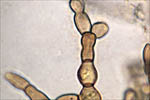
Figure 21 |
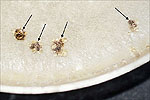
Figure 22 |
Rhizoctonia species can be divided into two groups based on the number of nuclei present in cells of the hyphae. This characteristic can be assessed by staining hyphae with a fluorescent dye that binds specifically to the DNA in the nucleus. Binucleate Rhizoctonia species have two nuclei in each cell (Figure 23). Rhizoctonia cerealis is the only binucleate species that causes turfgrass disease. Multinucleate species have three or more nuclei in each cell (Figure 24). Rhizoctonia solani, R. zeae, and R. oryzae are multinucleate species.
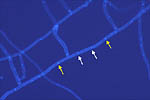
Figure 23 |
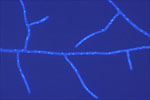
Figure 24 |
Species of Rhizoctonia are further divided into groups based on the ability of hyphae to fuse with one another, a phenomenon known as anastomosis. Anastomosis is the primary means of genetic recombination in Rhizoctonia, therefore, isolates within an anastomosis group are closely related to one another. As a result, isolates within anastomosis groups (AGs) tend to have similar host ranges. In some cases, anastomosis groups may be further divided into intraspecific groups based on morphological or physiological characteristics.
Rhizoctonia solani
Rhizoctonia solani forms colonies on potato dextrose agar (PDA) that range in color from buff to black (Figure 25). Sclerotia are produced on the surface of cultures after 4 to 6 weeks, and are irregularly shaped, light tan to black, and usually >1 mm (0.04 in.) in width (Figure 26). The optimum temperature for growth of R. solani in pure culture ranges from 18ºC (64.4ºF) to 28ºC (82.4ºF). This species is divided into 11 AGs. Isolates in AGs 1 and 2 are commonly associated with turfgrass disease.
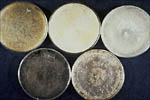
Figure 25 |
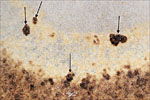
Figure 26 |
Rhizoctonia zeae and Rhizoctonia oryzae
Rhizoctonia zeae and R. oryzae produce colonies on PDA that are white, buff, or salmon colored (Figure 25). These species can be differentiated from one another based on sclerotial morphology. The sclerotia of R. oryzae are salmon colored, 1 mm (0.04 in.) to 3 mm (0.12 in.) in diameter, and form on the agar surface or submerged in the agar. The sclerotia of R. zeae are initially white, but eventually turn to orange then red or dark brown, are uniformly spherical, and form submerged in the agar medium. Each species grows optimally in pure culture at 32ºC (89.6ºF), and contains only one anastomosis group (R. zeae - WAG-Z; R. oryzae - WAG-O). Both of these species are less sensitive to dicarboximide fungicides than R. solani. In addition, Rhizoctonia zeae is less sensitive to benzimidazole fungicides than R. solani. These differences have important implications in the management of diseases caused by Rhizoctonia species, and increase the importance of proper disease diagnosis.
Rhizoctonia cerealis
Colonies of R. cerealis on PDA are white to buff colored (Figure 25), growing optimally at 23ºC (73.4ºF). Sclerotia are generally smaller than those produced by other Rhizoctonia species (0.3-1.2 mm, 0.01-0.5 in. diameter), are irregular in shape, and are initially white to yellow, eventually turning brown in color (Figure 22). This species contains a single anastomosis group, designated AG-D.
An additional Rhizoctonia species, designated Rhizoctonia AG-Q, has been associated with a disease similar to yellow patch in Japan. This species also produces white to buff colonies on PDA, but produces no sclerotia and grows more slowly than R. cerealis in culture.
Disease Cycle and Epidemiology
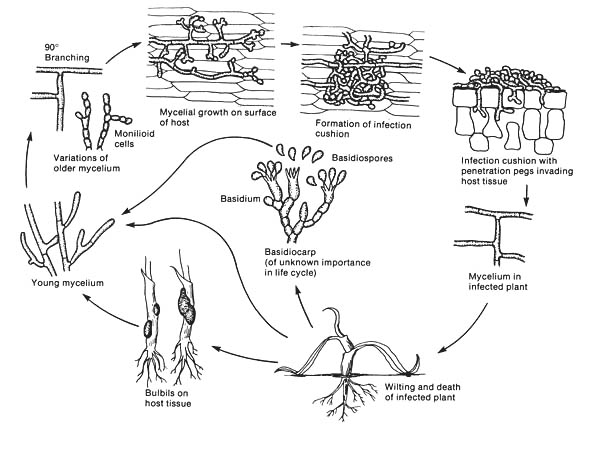
Rhizoctonia species are strong saprophytes. They are able to survive for extended periods of time in the absence of living host plants by feeding on decaying organic matter. When conditions are not favorable for growth, these fungi persist as mycelium or as sclerotia in the thatch and soil. When a host plant is present and environmental conditions are favorable, Rhizoctonia species begin to colonize the surface of the potential host plant with long, unbranched hyphae called runner hyphae (Figure 27). Depending on the isolate and host species, the runner hyphae may branch and penetrate through stomata or give rise to structures called infection cushions, which are aggregates of convoluted hyphae (Figure 28). Infection cushions of R. solani form most frequently along the edges of the vascular bundles (Figure 29) or over stomata. The infection cushions are involved in enzymatic degradation and physical penetration of the leaf surface, providing entrance into the plant for the pathogen. When sufficient moisture is present, Rhizoctonia species spread from plant to plant through the growth of hyphae among plant leaves (Figure 30).
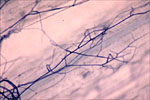
Figure 27 |
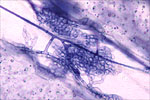
Figure 28 |
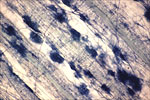
Figure 29 |
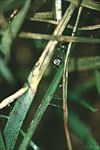
Figure 30 |
Rhizoctonia species are necrotrophic pathogens, meaning that they kill host cells before colonizing them. This is accomplished through the secretion of enzymes and toxins in advance of fungal growth.
Epidemiology
Brown Patch
Brown patch may occur when minimum air and soil temperatures exceed 18ºC (64.4ºF) and 15ºC (59ºF), respectively, but severe disease outbreaks occur only at higher temperatures (>25ºC or 77ºF). Periods of high relative humidity (≥95%) for at least 10 consecutive hours are required for disease development. Irrigation and/or rainfall events exceeding 2.5 cm (1 in.) are also conducive to brown patch.
Characteristics of the site and turf stand may also favor disease development. In general, factors that impede evaporation or drainage (poor air movement and soil drainage, excessive shade) are conducive to brown patch. Excessive nitrogen fertilization creates dense, lush turf that is highly susceptible to R. solani. Frequent use of organic fertilizers has also been associated with increased brown patch severity.
Large Patch
Large patch occurs in the fall and spring, when warm-season turfgrasses are entering or exiting their period of winter dormancy. Infection of the lower leaf sheaths by R. solani occurs whenever the temperature of the thatch layer is between 10ºC (50ºF) and 21ºC (69.8ºF), and continuous moisture is available for at least 48 hours. Warm-season grasses are not growing vigorously during the spring and fall, and are highly susceptible to pathogen attack. Patches may also develop in the summer during periods of cool weather, especially in wet or shaded sites.
Recent evidence indicates that the majority of large patch development occurs in the fall. Symptoms are observed in the spring because plants infected the previous fall have not yet recovered. As conditions become optimal for the growth of warm-season turfgrasses in late spring/early summer, recovery occurs due to the spreading growth habit of these grasses.
Excessive moisture levels in the soil, thatch, and lower turf canopy encourage large patch development. Factors such as poor drainage, shade, restricted air movement, or excessive irrigation increase the severity of this disease.
Leaf and Sheath Spot
Turf diseases caused by R. zeae and R. oryzae are more prevalent than R. solani at high temperatures (30ºC or 86ºF). Other factors that encourage brown patch development (i.e. moisture, excessive nitrogen) also favor the development of leaf and sheath spot.
Yellow Patch
Yellow patch development occurs at temperatures below 20ºC (68ºF). Yellow patch occurs most frequently in temperate climates during the transition from fall into winter and winter into spring. Factors that encourage brown patch development (i.e. moisture, excessive nitrogen) also favor the development of yellow patch.
Disease Management
Brown Patch
Cultural Management: Moisture and temperature are the most common factors limiting brown patch development. While temperature is not easily manipulated in most cases, several things can be done to control moisture availability. Rhizoctonia solani requires a minimum of 10 consecutive hours of leaf wetness or relative humidity ≥95% in order to initiate disease. Practices that reduce the amount of time that the turf canopy is wet or humid will therefore reduce the severity of brown patch.
Irrigation water should be applied infrequently, but in sufficient amounts to meet the water requirements of the turf. Irrigation should be timed so that the duration of leaf wetness is minimized. Early morning irrigation removes large droplets of dew and guttation water, which evaporate slowly, from the foliage and encourages rapid drying of the turf. Avoid irrigation for several hours prior to sunset; this will increase the amount of time that the turf canopy is wet and encourage brown patch development. When syringing turf during the day to reduce heat stress, ensure that the turf canopy dries completely between syringe cycles. If the turf is syringed too frequently, the turf canopy will be constantly wet, creating a perfect environment for development of diseases such as brown patch.
Early morning mowing also reduces leaf wetness duration by removal of large dew droplets and guttation water from the leaves. Alternatively, dew can be removed by dragging a pole, hose, rope, chain, or other object across the turf surface. This practice is known as "poling" or "whipping," and was the first disease control practice commonly used by turfgrass managers.
In areas where sunlight penetration and air movement are low, pruning or removal of surrounding trees and shrubs will help to reduce brown patch development by facilitating water evaporation and improving overall turf vigor. For high maintenance sites, such as golf greens, installation of high-powered fans increases air movement, speeds morning drying of the turf and reduces the incidence of several diseases.
Poor soil drainage also enhances brown patch. Where soil drainage is poor, installation of drainage tile, core cultivation to reduce soil compaction and thatch accumulation, and/or modification of the soil profile to increase porosity will reduce brown patch severity and improve overall turf quality.
Excessive levels of nitrogen fertilizer enhance brown patch activity through two mechanisms. First, high nitrogen produces soft, lush leaf tissue that is easily invaded by fungi such as R. solani. Second, nitrogen increases vegetative growth, therefore reducing air movement in the turf canopy, increasing humidity and leaf wetness. Nitrogen fertilizer should be applied in small quantities during the summer months to reduce brown patch severity.
Chemical Control: Fungicides in the following classes are effective for brown patch control: carboxamides, benzimidazoles, carbamates, dicarboximides, DMI fungicides, nitriles, and QO inhibitors. In warm, humid climates, where brown patch pressure is consistent throughout the summer months, preventative, calendar-based applications are recommended for brown patch control. In more temperate climates, where disease development occurs intermittently, applications may be made on a curative basis or according to a disease forecasting system.
Genetic Resistance: Turfgrass species vary significantly in their susceptibility to Rhizoctonia species. Among the bentgrass species used for golf course turf, creeping bentgrass is more resistant to R. solani than colonial bentgrass. For lawn and landscape turf use, Kentucky bluegrass and fine fescue species are often observed to be more resistant to R. solani than tall fescue or perennial ryegrass.
Within some turfgrass species, cultivars vary widely in their susceptibility to Rhizoctonia species. For information on turfgrass cultivars that perform best in your area, consult your local county extension office or visit The National Turfgrass Evaluation Program at: www.ntep.org.
Large Patch
Cultural Management: Control of moisture levels in the thatch and soil is an important aspect of large patch management. The disease is most severe in areas that have poor soil drainage, little air movement, or excessive shade. In areas that are poorly drained, installation of drainage tile, soil cultivation to reduce compaction and thatch accumulation, and/or modification of the soil profile to increase porosity will limit large patch severity and improve overall turf quality. Where air movement and sunlight penetration are low, pruning or removal of surrounding trees and shrubs is recommended. Irrigation should be applied as necessary to meet the water requirements of the turf.
Mowing height may also influence the development of large patch. On zoysiagrass, large patch severity increases as mowing height is decreased from 3.75 cm (1.5 in.) to 1.25 cm (0.5 in.). Reduced mowing heights result in a more dense turf stand, which may create a more favorable environment for large patch development by reducing air movement and increasing humidity in the lower turf canopy.
Chemical Control: Several fungicides are available for control of large patch. Fungicides in the following classes are most effective: carboxamides, benzimidazoles, carbamates, dicarboximides, DMI fungicides, nitriles, and QO inhibitors. In turf stands with a history of large patch development, preventative fungicide applications provide excellent control when timed properly. The first application should be made in the fall when conditions become conducive for large patch development, i.e. when the thatch temperature drops below 21°C (69.8°F) for several consecutive days. Subsequent applications should be made as specified on the fungicide label. Because the majority of disease development occurs in the fall, fungicide applications at this time are most important. However, when disease pressure is severe, spring applications may also be required to achieve adequate control.
Genetic Resistance: Little variation in large patch susceptibility is observed among the warm-season grasses. Bermudagrass, centipedegrass, St. Augustinegrass, and zoysiagrass incur similar amounts of damage due to activity of the pathogen. However, bermudagrass may recover from large patch damage more rapidly than other warm-season species because of its aggressively spreading growth habit. For the most updated information on turfgrass cultivars that perform best in your area, consult your local county extension office or visit www.ntep.org.
Leaf and Sheath Spot
Control of diseases caused by R. zeae and R. oryzae is achieved through means similar to those for brown patch. In laboratory studies, turfgrass isolates of R. zeae were less sensitive to benzimidazole and dicarboximide fungicides than R. solani. Results of a field test in Georgia indicate that these fungicides are less effective than flutolanil and azoxystrobin in suppressing disease caused by R. zeae on creeping bentgrass. Isolates of R. oryzae from rice are also less sensitive to dicarboximides than R. solani in laboratory studies, but turfgrass isolates have not yet been tested. Therefore, accurate identification of Rhizoctonia species is important for selection of fungicides for control.
Yellow Patch
Cultural Management: Like other Rhizoctonia diseases, the severity of yellow patch is enhanced by the presence of moisture in the turf canopy. Increasing soil drainage, air movement, and light penetration into the turf canopy will therefore reduce the severity of this disease. Excessive foliage enhances the incidence of several winter diseases, including yellow patch. Cool-season grasses should be mowed on a regular basis from the time foliar growth begins in the spring until it ceases in the fall. Also, avoid applications of nitrogen fertilizer in the late fall. Because yellow patch occurs during cold weather, irrigation practices are not relevant to the management of this disease.
Chemical Control: Several fungicides are available for the control of yellow patch. Fungicides in the following classes are effective for yellow patch control: carboxamides, benzimidazoles, carbamates, dicarboximides, DMI fungicides, nitriles, and QO inhibitors. Adequate control of yellow patch is usually provided by preventative fungicide applications for snow mold diseases.
Genetic Resistance: Few options are available for management of yellow patch with genetic resistance. Yellow patch is most common on golf course greens in temperate climates. In this situation, creeping bentgrass is the only species that is currently available for use. Some improved varieties of creeping bentgrass may have enhanced resistance to yellow patch. For information, consult your local county extension office or visit www.ntep.org
Historical Significance
Brown patch can be thought of as the "late blight" of turfgrass pathology, as it spurred much of the initial research on turfgrass diseases and their management. Brown patch was first observed in 1913 on a golf course putting green near Philadelphia, Pennsylvania. In 1919, C.V. Piper and H.S. Coe of the United States Department of Agriculture determined that Rhizoctonia solani was the causal agent of brown patch. Initially, morning dew removal by mowing, "poling", or "whipping" was the only practice available for management of brown patch. In 1917, experiments by the United States Golf Association demonstrated that brown patch could be controlled with Bordeaux mixture, and this material was in widespread use for turfgrass disease control by 1919. In 1927, field experiments at the Arlington Turf Gardens in Virginia demonstrated that mercury-based materials were most effective for control of brown patch and dollar spot. Mercury fungicides were commonly used until 1970, when their use was restricted because of their potential adverse effects on the environment.
Although R. solani was one of the first recognized turfgrass pathogens, new diseases caused by Rhizoctonia species continue to be described today. In 1978, yellow patch was initially described by P.L. Sanders and co-workers. Later, the causal agent was identified as R. cerealis by L.L. Burpee in 1980. Martin and Lucas (1984) and Haygood and Martin (1990) demonstrated that R. zeae and R. oryzae were pathogenic to cool- and warm-season turfgrass species. In 1993, D.E. Green and co-workers demonstrated that R. solani was the primary causal agent associated with large patch of zoysiagrass.
Selected References
Burpee, L.L. 1992. Assessment of resistance to Rhizoctonia solani in tall fescue based on disease progress and crop recovery. Plant Dis. 76:1065-1068.
Burpee, L.L. 1995. Interactions among mowing height, nitrogen fertility, and cultivar affect the severity of Rhizoctonia blight of tall fescue. Plant Dis. 79:721-729.
Burpee, L.L., and S.B. Martin. 1992. Biology of Rhizoctonia species associated with turfgrasses. Plant Dis. 76:112-117.
Couch, H.B. 1995. Diseases of Turfgrasses. 3rd ed. Krieger Publishing Company, Malabar, FL.
Fidanza, M.A. and P.H. Dernoeden. 1997. A review of brown patch forecasting, pathogen detection, and management strategies for turfgrasses. Intern. Turfgrass Soc. Res. Journal 8:863-874.
Fidanza, M.A., P.H. Dernoeden, and A.P. Grybauskas. 1996. Development and field evaluation of a brown patch warning model for perennial ryegrass turf. Phytopathology. 86:385-390.
Green, D.E. II, J.D. Fry, J.C. Pair, and N.A. Tisserat. 1993. Pathogenicity of Rhizoctonia solani AG2-2 and Ophiosphaerella herpotricha on zoysiagrass. Plant Dis. 77:1040-1044.
Gross, M.K., J.B. Santini, I. Tikhonova, and R.X. Latin. 1998. The influence of temperature and leaf wetness duration on infection of perennial ryegrass by Rhizoctonia solani. Plant Dis. 82:1012-1016.
Haygood, R.A. and S. B. Martin. 1990. Characterization and pathogenicity of species of Rhizoctonia associated with centipedegrass and St. Augustinegrass in South Carolina. Plant Dis. 74:510-514.
Kataria, H.R., U. Hugelshofer and U. Gisi. 1991. Sensitivity of Rhizoctonia species to different fungicides. Plant Pathol. 40:203-211.
Martin, S.B. and L.T. Lucas. 1984. Characterization and pathogenicity of Rhizoctonia spp. and binucleate Rhizoctonia-like fungi from turfgrasses in North Carolina. Phytopathology. 74:170-175.
Schumann, G.L., B.B. Clarke, L.V. Rowley, and L.L. Burpee. 1994. Use of environmental parameters and immunoassays to predict Rhizoctonia blight and schedule fungicide applications on creeping bentgrass. Crop Protection. 13:211-218.
Schumann, G.L. and J.D. MacDonald. 1997. Turfgrass Diseases: Diagnosis and Management. CD ROM. APS Press, St. Paul, MN.
Smiley, R.W., P.H. Dernoeden, and B.B. Clarke. 2005. Compendium of Turfgrass Diseases. 3d ed. APS Press, St. Paul, MN.
Smith, J.D., N. Jackson, and A.R. Woolhouse. 1989. Fungal Diseases of Amenity Turfgrasses. 3rd ed. E. & F.N. Spon Ltd, New York.
Tisserat, N.A., J.D. Fry., and D.E. Green II. 1994. Managing Rhizoctonia large patch. Golf Course Management 62(6):58-61.
Zhang, M. and P.H. Dernoeden. 1997. Rhizoctonia solani anastomosis groups and other fungi associated with brown patch-affected turfgrasses in Maryland. Intern. Turfgrass Soc. Res. Journal 8:959-969.
